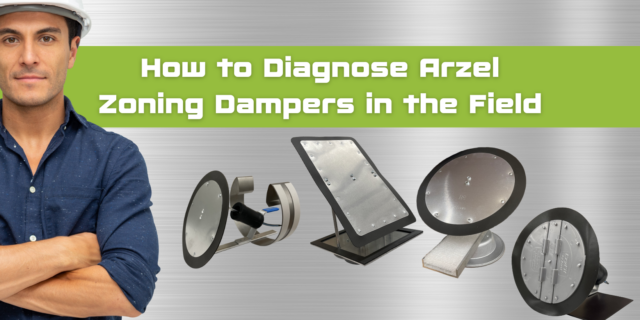Static Pressure and Summer Fun

Summer is here, and with that comes a rush of service calls. In that rush, as technicians, we often skip the basics of air conditioning performance. That starts with proper airflow. Air conditioning requires proper airflow and proper airflow changes with static pressure.
The Total External Static Pressure (TESP) corresponds to blower performance data charts. For example, electric air handlers might be as low as 0.3” W.C. In comparison, a conventional gas furnace could be 0.50” W.C. with maximums around 0.8” W.C. or up to 1.0” W.C. As the static pressure increases, the CFM delivered decreases. This is even true of variable speed or ECM motors; they only produce their rated airflow up to a maximum static pressure before CFM drops off. Typically for every 0.1” W.C. above 0.7” W.C. or 0.8” W.C., the blower output is reduced by 10% of its setting.
This negatively affects energy consumption but also affects refrigerant pressure and can lead to overcharging. Considering the cost of refrigerant today, that’s an expensive mistake.
Four places to measure static pressure
Static pressure is an especially important measurement in the transition from heating to cooling season, and in the peak of each one. Neglecting to measure static pressure means we can miss the root cause of many issues our customers are trusting us to diagnose. There are four points to test when measuring static pressure.
- Before Filter
- After Filter
- Before Coil
- After Coil
Before Filter and After Filter
Before Filter is a measurement in the return boot and gives us the return ducting’s external static pressure (ESP). ACCA Manual D recommends a return velocity of 600FPM which should put us around 0.07 to 0.08 ESP. If the test shows this is higher, the data tells us there is a potential restriction on the return side of the equipment.
After Filter is measured right where the air enters the furnace’s cabinet.
When we have both the Before Filter and After Filter, the difference between these numbers is the filter pressure drop; ideally, this shouldn’t exceed 20% of the equipment’s rated TESP for most residential applications. In addition, this difference shouldn’t exceed 0.1” W.C. clean, and when dirty, the filter shouldn’t exceed the allowance set by the equipment’s manufacturer; some might allow a maximum of 0.25” W.C. when the filter is loaded or dirty. If we exceed this, our filter is either dirty or undersized; this can lead to freezing evaporator coils and improper refrigerant pressure causing an overcharging of the Air Conditioner.
Before Coil and After Coil
Before Coil measures the air pressure as it leaves the cabinet of the furnace before it enters the evaporator coil; by adding the After Filter and Before Coil together, we get our TESP which should be between 0.3” W.C. up to a maximum of 0.7” W.C. While most furnaces will allow for a maximum of 0.8” W.C. a safety threshold allows for proper equipment operation if the filter gets dirty, or the evaporator coil is wet, collects some dust, or a register gets blocked.
After Coil is measured above the evaporator coil in the plenum. This is the ESP of the supply duct. Properly designed, it should be between 0.07” W.C. and 0.1” W.C. The recommended velocity of a supply trunkline is 700FP.
The difference between Before Coil and After Coil gives us a pressure drop across the coil. If this exceeds the engineering data, the coil is dirty and needs cleaning. If the data for the coil is unavailable, then a suitable pressure drop will typically not exceed 40% of the rated TESP, usually around 0.2” W.C.
Why measure static pressure at all four points?
Testing all four points is essential because it reveals to us if there is a restriction that will affect performance. For example, with the return ducting ideally designed for 600FPM and the supply ducting designed at 700FPM, the return duct is slightly larger, so our numbers should be slightly lower on the return versus the supply side. So it’s ok if the numbers are equal, but the return pressures shouldn’t exceed the supply pressures if the system were designed correctly.
If our pressure drops across the filter are too high, there’s an opportunity to upgrade the filter for performance by replacing the 16×25 filter with a 20×25 filter (the depths of the pleats 1” versus 4” have little impact on pressure drop).
If our ESP is high on the return or supply side, then the solution might be to reduce the blower speed so it’s moving less air. This may or may not be a problem for the air conditioner. We need high speed if it’s a 3-ton blower with a 3-ton air conditioner. If it’s a 3-ton blower with a 2.5-ton air conditioner, reducing the blower speed to match the outdoor unit is to our benefit.
If our blower already matches the outdoor unit’s CFM requirements, then it’s the perfect opportunity to improve the ducting for better performance.
As mentioned above, if the pressure drop across the evaporator coil is too high, then there’s an opportunity to clean the coil, improving performance and being more profitable with our time, focusing on quality over quantity.
What does static pressure have to do with zoning?
You may say to yourself what about zoning? Since this is a blog from Arzel Zoning, it’s a restriction that will cause high static pressure. You’re right. However, it’s a controlled and automated restriction and works within the pressure range for safe and effective system operation when properly designed. We’d love to discuss this in greater detail with our free training opportunities.






